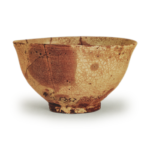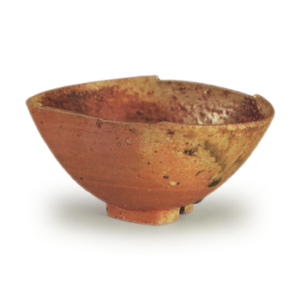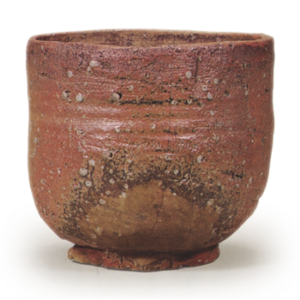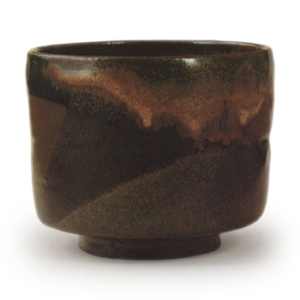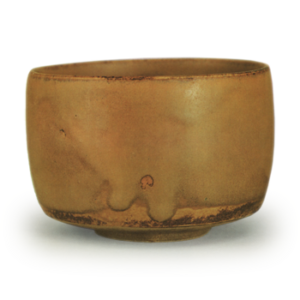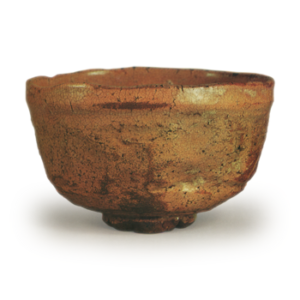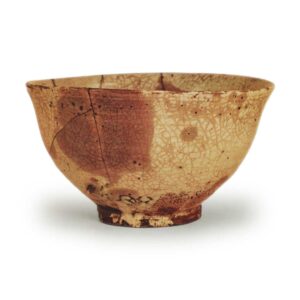
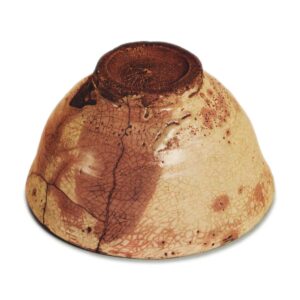
Held in the Matsunaga Memorial Museum
Height: 14.8 – 15.5cm
Diameter: 8.4 – 8.8cm
Outer diameter of foot: 6.3 – 6.5cm
Height of foot: 0.8 – 1.2cm
The Matsura family of Hirado were famous for their leaking tea bowls, and there is a legend that Lord Matsudaira Fumai made three lowly requests to obtain one, but the Matsura family would not part with it. This is an excellent tea bowl with a particularly large number of stains, and it has a bold yet elegant appearance.
The clay is white and fine, but when it is scraped, it has the property of forming creases, and it is covered in a generous amount of transparent white glaze. The foot ring is exposed, and it is stained reddish-black with tea stains, and there are rough cracks all over. The firing is slightly oxidized, and the color is a somber yellowish-brown, with the areas where the glaze has pooled becoming a powdery white. The shape is similar to the Kuma River shape, with a slightly tapered rim, but the foot is also solid and the overall shape is more imposing and larger than the Kuma River shape. The foot, which has been shaved off in one go, is bold and dynamic, and the rough creases on the shaved surface are one of the charms of this tea bowl.
On the inside, as with the Kumagawa, there is a mirror that is one level lower, and within this there are four eyes, the inside is dimpled in a spiral pattern, and there are large and small raindrops all over the surface, so the interior scenery is complex. There are vertical, horizontal and diagonal cracks in the body, which may have been caused by dropping the bowl, and the rain leaks are particularly noticeable in these areas. In addition, there are pores in the glaze, and the rain leaks seep in through the cracks in the rough crackle glaze where the clay is exposed. Rain leaks, like the spots commonly referred to as “spots”, are not caused by the intensity of the flames during firing, but are formed when tea stains seep into the clay body while the tea bowl is being used. Rain leaks are caused by the clay body’s high resistance to fire, and even after firing, the clay body still has water absorbency, so even Japanese pottery that has been fired poorly can develop rain leaks over time.
The rain leaks recorded in the Taisho Meiki Kan are the four pieces in the Nezu Museum collection that were originally owned by the Sakai family of Himeji, the rain leak “Muichimono” that was a favorite of Fujiwara Ginjiro, the rain leak “Minomushi” in the Nezu Museum collection “Musho”, and the ‘Yudzuka’ rain-leak from the Kobe Tamura family, although this rain-leak from the Hirado Matsuura family is not recorded, it is one of the outstanding tea bowls in terms of appearance, construction and scenery.
It was originally in the possession of the Matsuura family of Hirado, and was in the Nagao Museum of Art for a long time before and after the war, but it later became the property of Mr. Jinzaburo Takanashi, and was then returned to the Matsunaga Memorial Museum.
The inner box is black lacquered with gold powder lettering, and on the front is the word “Amamori”, and on the back is the phrase “The rain that falls on the eaves of the house that is being dug up is collected in layers and falls in a double rain shower”. It is said to have been written by Matsudaira Fumai.

